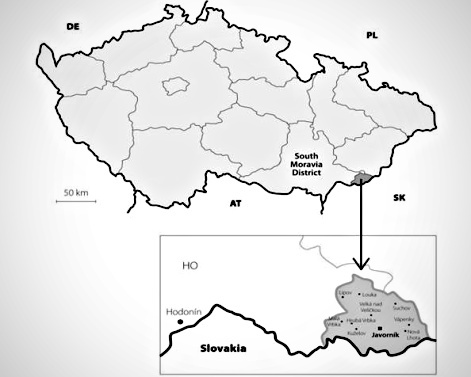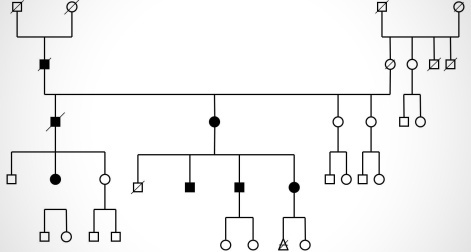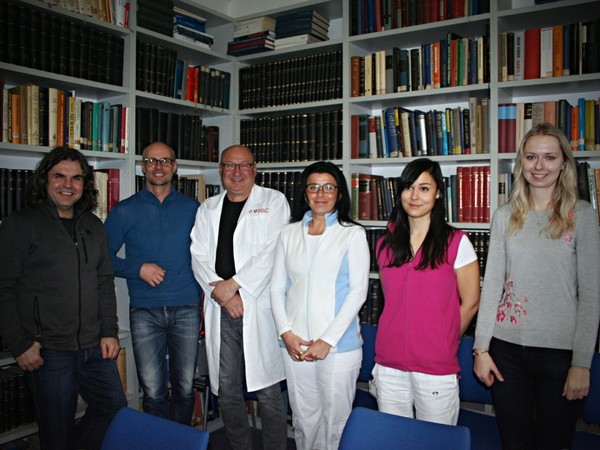A unique discovery was made by scientists from the UP Faculty of Medicine and Dentistry who have identified an unknown gene mutation responsible for the development of a new type of parkinsonism. It was found in the population inhabiting a specific region of south-eastern Moravia, with an abnormally high prevalence of this neurodegenerative disease. The ongoing research should contribute to a deeper understanding of its onset and development.
“Thanks to a detailed molecular-genetic analysis we have identified a completely new, previously unknown variant of parkinsonism, unique in the whole world. The possibility that it could be one of the atypical syndromes of Parkinson’s disease, described in modern neurodegenerative neurology, has been effectively excluded. It is practically a new disease,” explained Head of the Department of Neurology at the UP Faculty of Medicine and Dentistry, Petr Kaňovský.

The centre of the unusual number of patients with parkinsonism was found by the researchers from the Olomouc Department of Neurology in a geographically and ethnographically isolated region called Horňácko at the foot of the White Carpathians. They have confirmed the long-term observations and findings made by local physicians. “We have detected an almost three times higher incidence of parkinsonism compared to the common European population. At the same time, we have proven that this type is hereditary and does not occur anywhere else but in this region,” said Kateřina Menšíková, an associate professor at the Department of Neurology and the main investigator of one of the research projects.
Geographic and genetic isolation
Empiric findings made by outpatient doctors have been confirmed by an extensive epidemiological study. “In collaboration with the Palacký University Department of Preventive Medicine we conducted the study in one of ten specific villages, and then extended our research to the whole region,” said Kateřina Menšíková. The surveys and interviews with the village population were accompanied with the study of parish records, registers of births and deaths, and archive materials digitalised in the Moravian Land Archives in Brno and in the Lower Austrian Land Archives in Sankt Pölten. In collaboration with experts from the UP Department of Medical Genetics they created family trees reaching all the way back to the end of the eighteenth century, documenting the heredity of this type of parkinsonism in individual families.

“In some of the narrower trees, up to twelve persons suffering with parkinsonism were found within three generations,” explained Petr Kaňovský. “People living in those ten villages married among themselves, and entire generations were isolated from their surroundings. The precondition of genetic isolation thus escalated. This ‘population isolate’ significantly increased the probability of the disease’s transmission from generation to generation as well as the accumulation of its rarer variants,” said molecular geneticist Radek Vodička of the UP Department of Medical Genetics.
Discovery of rare gene variants
In the next stage of the research, patients with clinical symptoms of parkinsonism were hospitalised at the Olomouc neurology department, where they underwent a complete clinical and neurophysiological examination. Patients diagnosed with parkinsonism gave samples of their DNA for molecular genetic analysis.
“In the first stage, we used a detailed sequence analysis to find whether previously described casual mutations associable with parkinsonism were present. Not a single one of those was confirmed; however, we have managed to describe more than thirty variants associated with hereditary parkinsonism. In one of the family sub-trees, two rare gene variants called PARK15 and PARK17 were identified, correlating findings in the brain and clinical images,” said Radek Vodička. The team of experts was the first in the world to describe the pathological alterations in the brain tissue that cause those gene mutations.
Control study
The team of Olomouc neurologists and geneticists will continue working on the study with the aim to determine the exact genetic and morphological characteristics of the new type of endemic disease and to identify the causes of its emergence and development. One of the planned steps is the commencement of a cross-sectional study that should confirm that the newly found parkinsonism variants occur exclusively in the studied region of Horňácko. The complete epidemiologic and molecular genetic research will be conducted under the same methods in the area of the Chřiby Hills that shows similar geographical, economic, and population genetic characteristics. “It is a geographically analogous agricultural region with a similar way of farming and a similar development of its Slavic population of Moravian origin, at a sufficient distance from the originally monitored area,” added Kaňovský.
According to Kaňovský, the unique findings are also interesting from the social and historical perspective. The data obtained in the epidemiological study have for example shown that family trees with the highest occurrence of newly found hereditary mutations come from the village of Javorník. It is not clear where those gene variants have “migrated” from. “Javorník, unlike the other nine villages, has a majority Lutheran population, which is almost an anomaly in southern Moravia. Therefore, it can be assumed that the aspect of aristocratic ownership of the village during the seventeenth and eighteenth centuries comes into play. It had been originally owned by the Žerotíns, later the Magnis, who – along with the owners of other nearby villages – in the aftermath of the Bocskai and kuruc invasions brought new serfs from different regions: middle Slovakia, the Těšín (Teschen) region, or even Styria. And this population – together with Lutheran migration – created a melting pot in which a concentration of rare gene variants gradually occurred during several generations,” added Kaňovský.
Practising physicians and nurses from villages in Horňácko also took part in the research along with Olomouc experts from the Department of Neurology, Department of Medical Genetics, and the Department of Clinical and Molecular Pathology at the Palacký University Faculty of Medicine and Dentistry. The research was funded by two grant projects of the Czech Health Research Council. The first results, published in peer-reviewed journals, were awarded a prize for the best publication by the journal Czech and Slovak Neurology and Neurosurgery three years ago.
Parkinson’s disease belongs to a group of neurodegenerative disorders caused by a generally unknown mechanism, and leading to a gradual death of brain cells in certain regions. It results in motor dysfunctions and tremors, accompanied by advancing dementia.
Practising physicians and nurses from villages in Horňácko also took part in the research along with Olomouc experts from the Department of Neurology, Department of Medical Genetics, and the Department of Clinical and Molecular Pathology at the Palacký University Faculty of Medicine and Dentistry. The research was funded by two grant projects of the Czech Health Research Council. The first results, published in peer-reviewed journals, were awarded a prize for the best publication by the journal Czech and Slovak Neurology and Neurosurgery three years ago.
